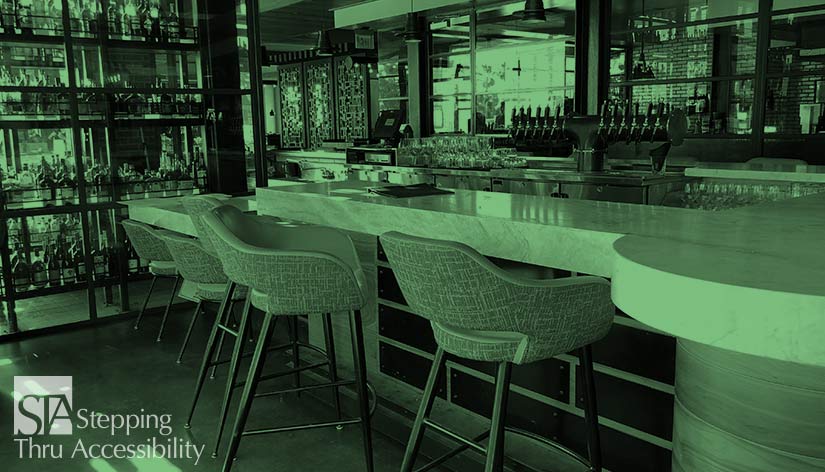Blog
Counters and Work Surfaces for Sales/Service and Dining/Bar — What Is Required?

Janis Kent, FAIA Architect, CASp © July 2019
There is discussion of what is allowed or required for a bar or dining surface and how it differs from a sales or service counter. Many times these two requirements can get confused with each other. Some of the main questions are, what is required if there is a split-height counter and what about the required clear floor space.
Sales and Service Counters
A sales or service counter is required to have the same depth at a minimum for the accessible portion as the overall depth of the countertop. This is the requirement per 904.4 of the ADA Standards. In their Guidance section, DOJ has clarified this as being applicable if the counter top is a single height. They have stated, though, that if the counter is a split height, then the accessible portion shall be the same depth as the non-accessible portion on the customer side. The countertop does not need to be the full depth of the overall counter. The employee side can be either higher or lower than the customer side. A front approach can be provided if there is knee/toe clearance below or a side approach can be used. ADA requires the surface to be at 36″ maximum above the finished floor whereas California Building Code (CBC) requires 34″ maximum. The issue to be concerned about is, for a side approach at 36″ high, one can not reach over a counter that is greater than 34″ above the finished floor.
Dining/Bar and Work Surfaces
A dining/bar or work surface is required to be between 28″ to 34″ above the finished floor for the accessible portion per 902. A forward approach is required in this case. This would mean that knee/toe clearance is to be provided below for a depth of 17″ minimum to 25″ maximum. CBC requires the depth to be 19″ minimum. There is nothing that states the surface is required to be the full depth of the counter similar to a sales/service counter, nor is there any discussion for split height surfaces. Therefor, the accessible portion of the surface can be a full or partial depth. I would say that for equivalency, though, the accessible customer portion should be at a minimum, the same depth as the non-accessible customer portion. If there is a split height to the counter, then site lines should be analyzed at the lower accessible portion particularly if there is food or drink preparation that is part of the experiential nature of the facility.
For sales and service counters, one of each type in each area is to be accessible and to be open at all times whenever the business is open to the public. Many times businesses keep the sales counter near the entry open as the prime sales counter. If this is the case, then consideration should be given to making this the accessible sales counter to ensure an accessible counter is always staffed and available.
Read more articles about accessibility in hospitality and retail »
For dining and bar counters, 5% of the seating or standing spaces are to be accessible and dispersed. If the counter is built-in, then the accessible spaces are also to be built in – a loose table can not be used as a substitute. For each accessible portion, CBC requires a lowered 60″ wide portion. This lowered accessible portion is not reserved only for access. I would suggest placing the correct height chair or stool at the lowered portion of the counter. A 34″ height counter should have a counter-height seat, vs a bar height seat or a table height seat. This makes the surface usable for a companion or someone who is able-bodied as well.
In both cases, employees will need to be able to reach over the counter to serve customers, whether the high or low portion regardless of depth. If a counter is altered to have an accessible portion, it should be visible and not placed around the side where it is hidden. This makes access difficult since now you have to ask where the accessible portion is located. And one other item – a flip-up or pull-out counter really can not be used in new construction and should only be considered as part of a barrier removal task.
Be aware that your local City or County may have additional requirements that are more restrictive than the State or Federal requirements. Also, this article is an interpretation and opinion of the writer. It is meant as a summary – current original regulations should always be reviewed when making any decisions.
© Janis Kent, Architect, FAIA, CASp July, 2019
Contact us for more information about our consulting services
Inquire About Consulting Services
Contact us for more information about booking public or seminars on this topic or others